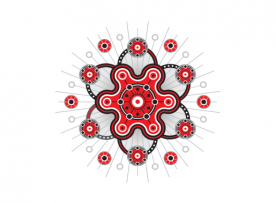Discover more about the Indigenous Research Unit and our story
The Indigenous Research Unit comprises people, partnerships and resources dedicated to the development and support of Indigenous research.
The establishment of the Unit was a key milestone in Griffith University’s Aboriginal and Torres Strait Islander research strategy.

Our logo, our story
The Indigenous Research Unit logo represents all that the Unit stands for:
- community
- strong partnerships
- community-driven research
- growing our own.
These elements are explained in more detail below.
We develop and maintain productive relationships with Aboriginal and Torres Strait Islander people within the University. Through these relationships, career and educational pathways are supported, with a specific focus on community-driven and applied research.
This is represented by the innermost circle of black dots in the illustration. This circle also represents a meeting place.
Our members come from various faculties and schools and have connections with other research centres. Our emphasis is on strong partnerships that will increase opportunities for Aboriginal and Torres Strait Islander people in terms of career and educational prospects.
The white circles are connected to our Community from our participation within. The black dot and the circles become part of our foundation by the red and black lines embracing the full structure.
We pursue projects identified by the community. This requires proactive dialogue and engagement with community members.
Each circle outside the main internal structure represents different Communities that have a pathway into the Unit (black curved line with white dots) and an outcome from the relationship that will help shape the community (black line with a red line embedded). These pathways are a cycle representing a dynamic relationship that can be strengthened over time.
We aim to grow our research portfolio, resulting in strong relationships with various Aboriginal and Torres Strait Islander communities. From this research, we will also develop our own approaches to research and grow the body of knowledge in this area. We will also work towards ‘growing our own’ Aboriginal and Torres Strait Islander academics and postgraduate students through pathways from undergraduate to postgraduate studies in partnership with the GUMURRII Student Support Unit.
This growth is represented by the grey lines in the background reach outwards and expanding.
Our staff
Director
Research Excellence Officer
Mr Ashley Fox
Senior Research Assistant
Project Coordinator
Ms Angela Bautista
Advisory Committee
Our Advisory Committee provides valuable input and advice in regard to:
- current and developing Indigenous research priorities, policy and planning within the higher degree sector and wider community
- engagement and promotion of the University’s Aboriginal and Torres Strait Islander academic and higher degree researchers and their projects
- the Indigenous Research Unit’s strategic direction.
Partnerships and collaborations
Our collaborative partners have included:
- University of Melbourne and Charles Darwin University
- The Lowitja Institute, Queensland Aboriginal Islander Health Council, Queensland Health and The University of Queensland
- QIMR Berghofer Medical Research Institute
- James Cook University
- University of Copenhagen
- University of Toronto
- University of Waterloo
- University of British Columbia
- Central Queensland University
Our resources
Our office is based in the Patience Thoms Building at Brisbane South (Nathan) and has a broad view of the surrounding bushland. Our open-plan office can accommodate up to eight visiting researchers in addition to the administrative team. Indigenous Research Network members can book our boardroom for meetings and the space can be altered to create an intimate workshop environment if needed. Our boardroom contains a large internet active projector screen and teleconferencing facilities. Members are also able to access computing equipment, hot desks and research assistant desk space to support their research projects.